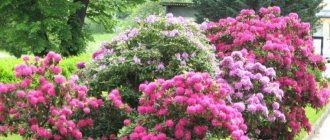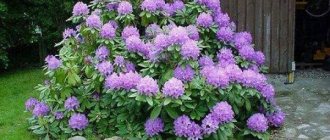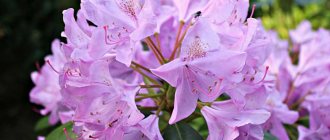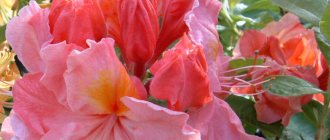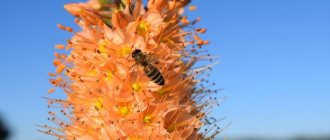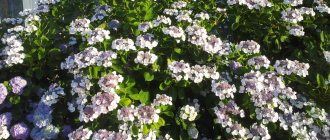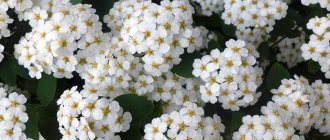History of origin
Rhododendron Haaga, according to historical information, was bred in Finland in 1974 at the University of Helsinki. This is the fruit of selection based on the Katevbinsky variety of rhododendrons. To date, more than 80 varieties of this type of rhododendron are known.
Rhododendron Hague - an evergreen shrub with lush flowers
For your information! On the Internet you can find another name - rhododendron Gaga, but this is just a mistake in spelling the variety. Only the Hague rhododendron appears in the botanical encyclopedia.
This species has a spherical crown of regular shape, quite branched and dense. The shrub is evergreen, perennial, reaching 1.5-2 m in height and up to 1.5 m in width. Unlike the more famous wild rosemary in Russia, wild rosemary has much denser inflorescences - up to 20 flowers per branch. The branches are gray, smooth, the flowers are large, rich pink in color with a scattering of red spots on the inside, wavy along the edges.
The leaves are dark green, up to 8 cm long and up to 5 cm wide. The petiole reaches a length of up to half the size of the leaf. The hybrid rhododendron Haaga blooms for a short time, only 2-3 weeks, starting in mid-June. Can grow both in partial shade and in the sunny side.
Distinctive features include a significant foliage part (unlike other varieties), large and lush inflorescences during the flowering period. Plus it is evergreen.
Important! The evergreen shrub changes its foliage every two years, and in winter it rolls its leaves into a tube, reducing moisture evaporation.
Application in garden landscape
Daughter of the North is most often used in the garden landscape as a ground cover, since it is low, but grows very well in width, and its bushes are quite dense. This variety also looks very impressive in the foreground of multi-level compositions that are created for landscaping garden plots and parks. It is often planted in groups along paths, used to zone space and create low hedges.
Compact rhododendrons combine well with conifers such as thuja and hemlock. In addition, thuja can protect miniature bushes from the wind. Of the deciduous trees, tree hydrangea is perfect for company with rhododendron, especially if you choose varieties with well-matching shades of inflorescences.
Use in landscape design
Rhododendron Helliki: description
Rhododendrons of the Hague variety feel great on the northern side of the site, in the shade of buildings or coniferous and fruit trees.
Note! The plant has a shallow and wide root system, so it will not take root next to crops with a similar structure of root systems.
Also, rhododendrons love moisture, so you can approach their cultivation creatively by planting them near artificial reservoirs, the flowering will be bright and lush. The presence of pine needles in the soil will also have a beneficial effect.
Rhododendrons love partial shade and grow well in the shade of trees.
Conditions for growing hybrid rhododendron The Hague
To grow rhododendron variety Hague, it is necessary to provide it with a number of conditions. The plant requires a certain microclimate, which includes lighting, air and soil humidity, and soil composition.
Conditions for successfully growing rhododendron Hague:
- diffused sunlight or partial shade;
- protection from cold wind;
- acidic fertile soil rich in humus;
- supply of fertilizers;
- soil moisture.
Rhododendron is ideal for decorating shady areas of the garden. The plant gets along well next to evergreens and ornamental shrubs. Buildings, fences and large trees provide protection from the wind.
Advice! Bright rhododendron flowers look spectacular surrounded by pine, spruce, cypress or green lawn.
The shrub develops best on loamy and sandy soils. Permissible acidity is from 4.5 to 6.5. The soil must be well-permeable to moisture and air.
How to plant rhododendron
Rhododendron Haag, like its fellows, loves acidified soils that are well drained without stagnation of groundwater or other waters. Planting is best done in prepared soil with a mixture of soil, acidic peat and rotted pine needles in a ratio of 3:1:2.
Rhododendron: planting and care in open ground
Before planting, dig up the soil to remove weeds. Then they dig holes measuring approximately 70 by 70 cm. The distance between the bushes should be at least 1.5 m.
If the soil is heavy, then make a drainage layer of about 15 cm at the bottom of the hole, and then fill in the prepared soil mixture. The rhododendron is placed in the hole, digging in, but not compacting, the soil.
Important! The root collar of the plant should not be buried in the ground, as this will lead to the death of the plant.
A furrow for irrigation is made around the bush at a distance of about 0.5-1 m from the root neck and the seedling is watered abundantly. The soil is mulched with peat or pine needles, making the layer thickness up to 8 cm.
What you need to know about planting rhododendron on the site
Choosing a landing site. This plant prefers partial shade, but does not like drafts. Therefore, the place you allocate to the rhododendron should be protected from the wind. The plant also does not encourage direct sunlight and stagnant water. Experienced flower growers say that it is better to plant rhododendron on the north side of the building, and ideally near bodies of water where the air is constantly humidified.
It is not advisable to plant rhododendrons next to birches, maples, lindens, alders and willows, since the root system of these trees greatly depletes the soil. But pine trees, on the contrary, are ideal neighbors for shrubs: their roots lie deep, and due to their height they do not deprive plants growing nearby of light.
Preparing soil for planting. Rhododendrons love loose, well-drained soil rich in humus with a pH level of 4.0-5.5. But don’t overdo it: if there is too much acid, the shrub runs the risk of developing chlorosis. There are several formulations that are ideal for rhododendron. For example, you can mix acidic peat, garden soil and pine bark in a ratio of 3:0.5:1 and add a little perlite to the soil mixture. The second option is acidic peat, coniferous and leaf soil and river sand in a ratio of 3:1:2:1. The third is pine bark, high-moor peat and turf soil composted for several years in a ratio of 2:2:1.
Preparing the hole and planting the plant. Since the hole should be 3-4 times the size of the root system of the rhododendron seedling, it is better to make the hole 0.5-1 m deep and 1-1.5 m wide. Place gravel or expanded clay at the bottom of the hole and fill the hole halfway with prepared soil. The roots of the plant are straightened and planted on top of the soil, then watered well with water at room temperature, the remaining soil is poured on top and compacted. The plant is watered and mulched with pine bark.
This planting method is not suitable for seedlings with a closed root system: they are planted exclusively by transshipment.
After about a week, the soil is leveled, leaving a small depression for easy watering. If there are several plants, then the interval between them should be at least 1 m. Medium-sized bushes are planted at a distance of 0.7-1.5 m, tall bushes - 2-2.5 m from each other.
How to propagate
It is possible to increase the population of rhododendrons of the Hague variety only by cuttings and layering, since planting seeds does not guarantee the preservation of color qualities and specific properties of new bushes.
Deciduous rhododendron: varieties, planting and care
Cuttings are made from partially lignified branches. Pruning is done in July, and the size of the cuttings should not exceed 10 cm. The lower leaves are removed, and the cuttings are dipped in a growth-stimulating solution for 15 hours. Then the cuttings are planted in a peat-sand mixture in a ratio of 1:1, maintaining an angle of 30°, and covered from above glass or polyethylene cap, avoiding contact with the branch.
Note! For successful germination of the root system there must be constant humidity and warmth. In this case, the roots will appear within 2-4 months.
Rooted cuttings are planted in a peat-coniferous mixture with a distance of a meter between future bushes, and they are transplanted to a permanent place after a year or two.
Cuttings of rhododendrons
For many, the layering method becomes simpler and more effective. To do this, choose strong shoots that are closest to the ground. At the point where the branch touches the ground, a longitudinal cut is made, fixing it in the open state. The shoot is secured in the hole with a bracket; a part of the branch of about 20 cm should remain at the top. The rooted shoot is sprinkled with soil, watered and fed.
Important! A new bush can be cut off from the mother one and planted in a new place only after two years.
Reproduction
For the Hague rhododendron, vegetative propagation methods are used. New plants are obtained using cuttings or layering. If you collect and plant seeds, this does not guarantee the preservation of flower color and decorative properties of the resulting seedlings.
For cuttings in July, choose strong, half-lignified branches. They are cut to a length of 8 cm and placed in a growth stimulator solution for 15 hours. Then the cuttings are transplanted into a substrate consisting of peat and sand. They are covered with polyethylene or a glass jar on top. Rooting occurs in high humidity and warmth. In cuttings, the root system appears after 3 - 4 months.
Important! Cuttings of the Hague variety are transplanted into containers with peat and pine needles. Plants are transferred to a permanent place after 1 - 2 years.
To propagate rhododendron by layering, select several strong shoots. They are lowered into the prepared holes and secured with staples. Then the branches are covered with earth and a 20 cm long top is left on the surface. The cuttings are watered and fed throughout the season. New branches appear from the eyes of the shoots. New shoots are planted from the mother bush after 2 years.
Description of rhododendron care
Growing a healthy and strong plant in open ground is not difficult if you follow simple care rules. These include pruning, fertilizing and mandatory preparation for winter.
Rules for pruning plants
Every spring and autumn, the bush needs sanitary pruning. Dry, broken and frozen branches are cut 3-5 cm below the damage. The same applies to the strong growth of rhododendron, but it is important to do this during a period of slow sap flow.
Rejuvenating pruning of the Hague rhododendron has the following description: all shoots are cut 15 cm from the tops, the cut points must be processed using standard methods.
How to prepare a plant for wintering
Despite the fact that the variety is characterized by sufficient winter hardiness, it is recommended to carefully cover young rhododendron bushes in the first 2-3 years in open ground. Before frost, approximately in the second half of October, the plant is watered abundantly and the root system is carefully covered with spruce branches or oak leaves. In areas of severe frost, non-woven fabric is additionally used, which is left until the onset of April. The spruce branches or foliage are removed only in May.
How to fertilize rhododendron
Feeding is not very important for the plant, but it can make its flowering much more magnificent. Rhododendrons are fed from May to July. Ready-made mineral complexes are well suited, most importantly, the absence of chlorine or lime. It would also be a good idea to use rotted manure on top of the soil in the fall or spring.
Weak or non-blooming buds are a sign of existing problems
What to do if buds do not appear
The lack of buds and flowering may be primarily due to lack of moisture. This will also be signaled by the leaves of the plant being wrapped in a tube. Another reason is the increased hardness of the water, as well as the predominance of nitrogen in the soil. In this case, the foliage will be abundant, green and lush in the absence of flowers.
In this case, care for the plant as follows:
- increase watering with rainwater or water with several spoons of top soil;
- Be sure to feed with manure in the spring, phosphorus and potassium fertilizers in late June-early July, and potassium fertilizer in the fall.
Step-by-step care instructions
Landing place
Rhododendron thrives in both sun and partial shade. But when planted in open places, the flower requires protective shaded shelters from bright sun and wind.
Rhododendron Hague grows well near bodies of water - moist air is preferable for its cultivation .
Despite its frost resistance, drafts and windy places should be avoided when planting in the garden.
The soil
The soil for Hague rhododendron should be loose and acidic. Soil composition:
- Drainage base.
- Turf soil – 1 hour.
- Heather land – 2 hours.
- Peat – 3 hours.
- Coarse sand – 1 hour.
REFERENCE! The soil must be loosened carefully - the roots of the Hague rhododendron are located close to the soil surface, and weeds must be removed manually.
Rooting
Rhododendron Hague is planted in spring or autumn. You cannot plant during flowering and 10-14 days after it. Planting rhododendron The Hague:
- Dig a hole 40–45 cm deep and 55 cm wide.
- It is important to place a layer of drainage 10–15 cm thick at the bottom of the hole.
- Pour the pre-prepared soil mixture into the hole, lightly compacting it.
- Make a hole and place a seedling there.
- Cover with substrate up to the level of the root collar.
- Requires abundant watering.
- It is advisable to mulch the soil to a thickness of 5–6 cm.
ATTENTION! For better rooting during flowering, the young Hague rhododendron needs to be cut off its lush inflorescences.
Mulch composition:
- Moss.
- Rotten needles.
- Peat.
- Pieces of oak bark.
- Oak leaves.
Temperature
Rhododendron Hague is a particularly frost-resistant variety and can withstand temperatures down to – 35° C. It is necessary to maintain constant high air humidity, then the flower will more easily endure the hot and dry summer. The optimal temperature for rhododendron is 12 – 15 ° C/
Watering
Rhododendron Hague requires abundant watering and daily spraying in summer . In winter and autumn, watering is reduced; watering should be done only on dry days. It is recommended to water with rain or settled cool water. You can water it with a weak solution of sphagnum peat - after soaking a small amount of it for a day.
Top dressing
Fertilizing begins immediately after planting. Fertilize the soil during the entire flowering period. To acidify the soil, superphosphate, calcium, and ammonium are added to the water. In early spring, fertilizers should contain nitrogen - per 10 liters of water - 4 - 5 g of magnesium sulfate. In mid-summer, the concentration of fertilizers is reduced by 2 times.
Trimming
In order to rejuvenate an adult Hague rhododendron, the tops of well-developed shoots are pruned in the spring . The cutting areas are treated with garden varnish.
After 30 days, young shoots will begin to grow intensively, dormant buds will begin to break through. Old and damaged branches are also cut off by a third.
Transshipment
The Hague rhododendron is replanted in the spring; it can be replanted before and after flowering. The flower is quite hardy to transplantation and quickly gets used to new conditions. Substrate for transplantation:
- sour peat – 2 hours.
- sawdust – 1 hour.
- sand – 1 tsp.
- sulfur – 40g.
All types of rhododendrons have a special elegant appearance. That's why they are so loved by gardeners. But in order for this flower to delight you with its chic appearance, you must follow special rules for caring for it. In other articles on our website we will talk about how to care for rhododendron Yellow, Francesca, Roseum Elegans, Adams, Cunningham's White, Yakushemansky, Ledebura, Caucasian, Nova Zembla and Daursky.
Diseases and pests
Shrubs of this family are susceptible to fungal diseases. This is due to increased humidity both in the air and in the soil, as well as poor air permeability of the earth. In this case, dark spots appear on the plant. Various preparations containing copper, for example, Bordeaux mixture, will help cope with this. It is necessary to spray the bush with excess, preferably in the evening.
Important! If moisture gets on the plant in sunny weather, it will cause severe burns.
If necessary, spraying is repeated after a week.
To protect rhododendrons from insect pests such as spider mites, weevils and others, the use of karbofos and similar preparations is suitable.
Rhododendron Hague is perhaps the best plant that can decorate gardens and farmsteads in the changing Russian climate. Even a novice gardener can plant and care for young seedlings.

